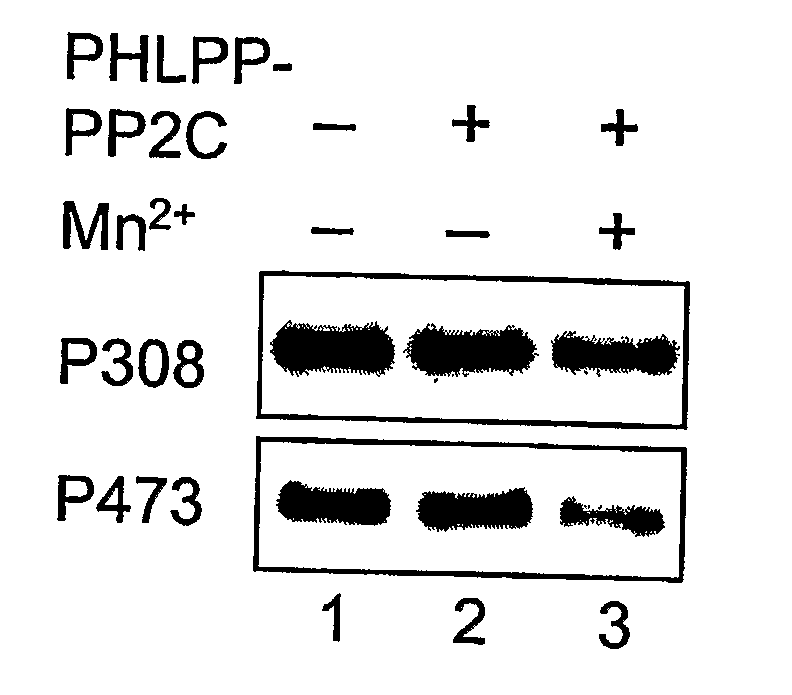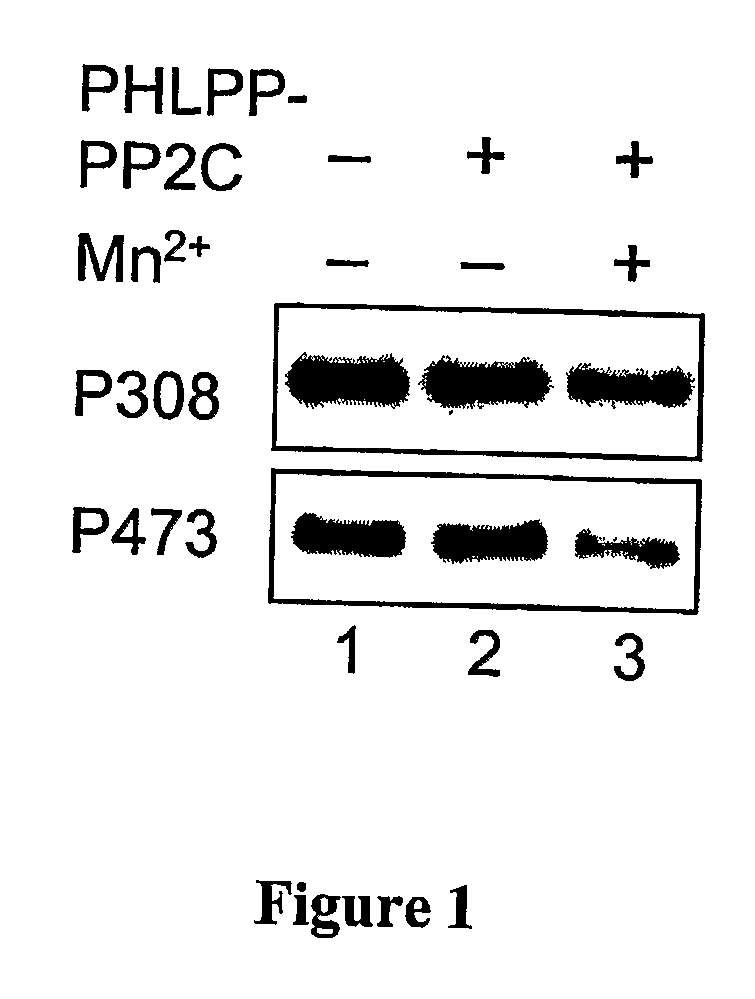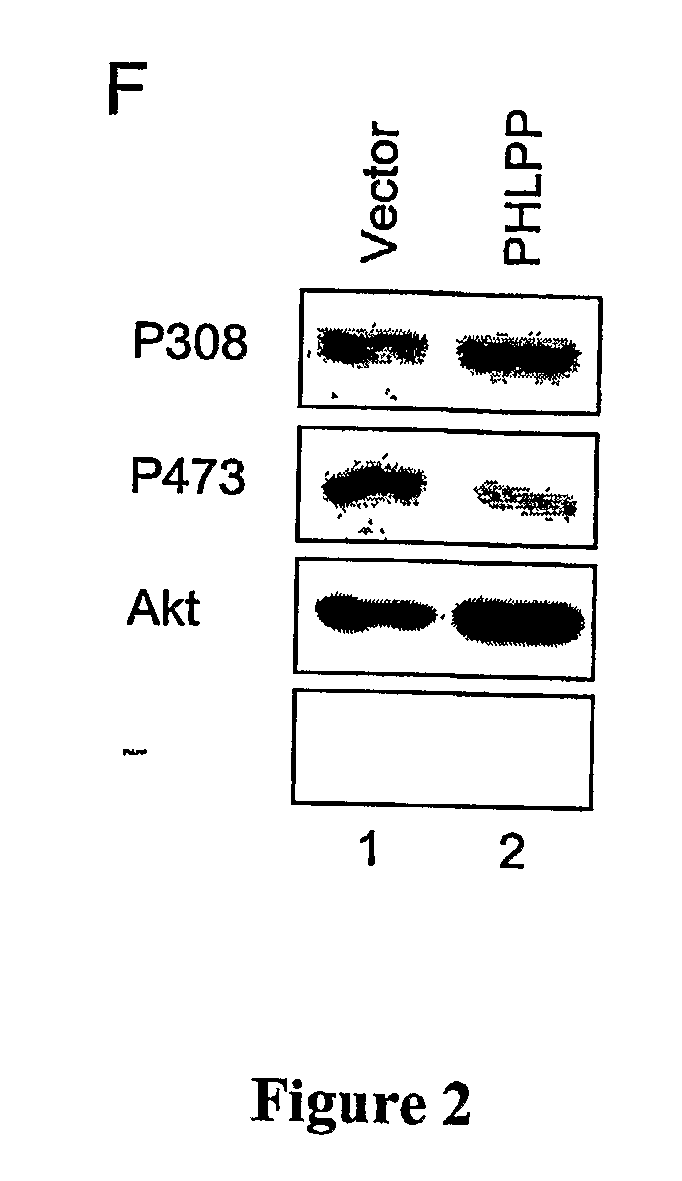Compositions and Methods for Treating Diseases Associated With Phlpp
a phosphatase and ph domain technology, applied in the field of phlpp polynucleotide polynucleotide composition and method, can solve the problem that the actual phosphorylation state of the corresponding site on akt is often uncoupled in cells
- Summary
- Abstract
- Description
- Claims
- Application Information
AI Technical Summary
Benefits of technology
Problems solved by technology
Method used
Image
Examples
example 1
PHLPP-1α Molecular Cloning and Construction of Expression Plasmids
[0327] The full-length human PHLPP-1α cDNA was cloned by combining the following cDNA fragments: KIAA0606 in Kazusa cDNA collection, an EST cDNA available from ATCC—GenBank access number: BG110729, and a RT-PCR product using a mixture of human fetal brain cDNAs (Marathon-Ready cDNA from BD Biosciences Clontech) as the template. The 5′ end of PHLPP-1α mRNA was confirmed using the 5′-RACE method with human brain Marathon-Ready cDNA. The pcDNA3HA vector was created by inserting the cDNA coding sequence of a HA tag (MGYPYDVPDYA; (SEQ ID NO: 6) into Bam HI and EcoR I sites on the pcDNA3 vector. To express HA-tagged wild-type and a PH domain deletion mutant (APH, deletion of amino acid residues 1-125, SEQ ID NO: 7) of PHLPP-1α in mammalian cells, the corresponding cDNA fragments were amplified using PCR. The PCR products were subcloned into EcoR I and Xho I sites on the pcDNA3HA vector to yield HA-PHLPP-1α and HA-APH expre...
example 2
PHLPP-1α In Vitro Phosphatase Assay
[0328] A GST-fusion protein of PHLPP-1α-PP2C was expressed in BL21 (DE3) and purified using glutathione-Sepharose. The GST-PP2C proteins were eluted from the beads in PBS containing 10 mM glutathione and 1 mM DTT, and dialyzed against 50 mM Tris (pH 7.4) and 1 mM DTT. His-tagged Akt was expressed and purified from baculovirus-infected Sf21 cells. Briefly, Sf21 cells were maintained in SF-900 II media (Invitrogen) and infected with baculovirus encoding His-Akt for 3 days. To obtain maximally phosphorylated Akt as substrate, the infected cells were treated with 10% FBS and calyculin A (100 nM) for 15 minutes prior to lysis. The infected cells were lysed in PBS containing 1% Triton X-100 and 10 mM imidazole, and His-Akt proteins were purified using Ni-NTA beads (Qiagen). The dephosphorylation reactions were carried out in a reaction buffer containing 50 mM Tris (pH 7.4), 1 mM DTT and 5 mM MnCl2 at 30° C. for 0-30 minutes.
example 3
PHLPP-1α Cell Transfection and Western Blotting
[0329] 293T, H157, MDA-MB-231, LN229, LN319 and LN444 cells were maintained in DMEM (Celigro) containing 10% fetal bovine serum (FBS, Omega Scientific) and 1% penicillin / streptomycin at 37° C. in 5% CO2. DLD1 and HT29 cells were maintained in Iscove's MDM (Invitrogen) containing 10% FBS and 1% penicillin / streptomycin at 37° C. in 5% CO2. Transient transfection of all cell types was carried out using Effectene reagents (Qiagen). Lipofectamine 2000 (Invitrogen) was used to transfect siRNAs into 293T and H157 cells. For Western blotting, the transfected cells were lysed in buffer A (50 mM Na2HPO4, 1 mM sodium pyrophosphate, 20 mM NaF, 2 mM EDTA, 2 mM EGTA, 1% Triton X-100, 1 mM DTT, 200 μM benzamidine, 40 μg ml−1 leupeptin, 1 mM PMSF). The detergent-solubilized cell lysate was obtained by centrifuging the whole cell lysate in a microcentrifuge at 13,000 rpm for 2 minutes. The detergent-solubilized lysates were separated on SDS-PAGE gels. ...
PUM
| Property | Measurement | Unit |
|---|---|---|
| molecular weight | aaaaa | aaaaa |
| molecular weight | aaaaa | aaaaa |
| molecular weight | aaaaa | aaaaa |
Abstract
Description
Claims
Application Information
 Login to View More
Login to View More - R&D
- Intellectual Property
- Life Sciences
- Materials
- Tech Scout
- Unparalleled Data Quality
- Higher Quality Content
- 60% Fewer Hallucinations
Browse by: Latest US Patents, China's latest patents, Technical Efficacy Thesaurus, Application Domain, Technology Topic, Popular Technical Reports.
© 2025 PatSnap. All rights reserved.Legal|Privacy policy|Modern Slavery Act Transparency Statement|Sitemap|About US| Contact US: help@patsnap.com



